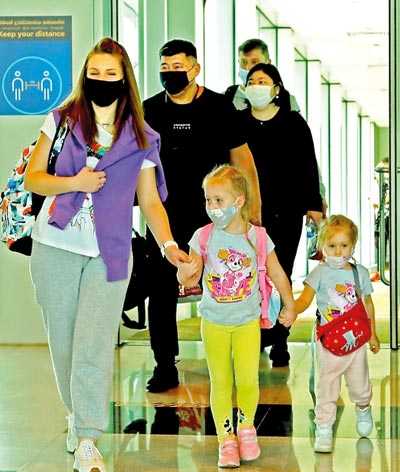Sunday Mar 09, 2025
Sunday Mar 09, 2025
Wednesday, 5 May 2021 00:31 - - {{hitsCtrl.values.hits}}
 Global business travel spending plunged by 60% year-on-year to $ 504 billion amid the pandemic, while leisure travel spending dipped 50% below pre-COVID-19 levels, according to data presented by Aksjebloggen.
Global business travel spending plunged by 60% year-on-year to $ 504 billion amid the pandemic, while leisure travel spending dipped 50% below pre-COVID-19 levels, according to data presented by Aksjebloggen.
The COVID-19 pandemic turned the global travel and tourism industry upside down in 2020, grounding airlines, emptying hotels, and stopping almost all business and leisure travel for months.
Although hotels and resorts implemented increased safety and sanitation measures and cautiously reopened in the second half of 2020, the pandemic’s second wave brought a new hit to the entire sector, causing revenues to plunge to the lowest point in decades.
83% of business travel companies laid off employees
The contribution of business tourism to the total global GDP has fluctuated slightly since 1995, always staying in the range of 0.6% and 0.8%. In 2019, the US was the country with the highest business tourism spending globally, revealed the World Travel and Tourism Council (WTTC) data. The overall US expenditure on business trips by domestic and international travellers amounted to around $ 354 billion that year. The European Union and China followed on the ranking, recording business travel spending of roughly $ 241 billion and $ 179 billion, respectively.
However, the COVID-19 changed that, as travel was limited to reduce the spread of the virus. In 2019, the global business travel spending hit an all-time high of nearly $ 1.3 trillion. After the COVID-19 struck, this figure plunged by $ 790 billion to the lowest level in decades.
As a result, most business travel companies were forced to make huge cuts. According to a February 2021 Global Business Travel Association (GBTA) study, 83% of respondents stated that their companies implemented layoffs. Also, 74% of the respondents claimed their business travel firms furloughed employees, and the same percentage confirmed pay cuts.
Another GBTA survey conducted in March showed that only 28% of companies have considered resuming domestic business travels in the near future, between one and three months. In contrast, just 8% of respondents stated their firms would continue international business trips within the same period.
Leisure tourism spending plunged by $ 2.3 trillion in a year
As the largest sector of the tourism industry, leisure travel also suffered colossal revenue losses last year. Between 2010 and 2019, global leisure travel spending doubled and hit nearly $ 4.7 trillion. However, after the COVID-19 hit, market revenues plunged 50% year-on-year to $ 2.3 trillion in 2020, deep below 2005 levels.
The Statista survey showed it would take years for the entire sector to recover from the effects of the coronavirus pandemic. In 2021, the combined revenues of the hotels, cruises, package holidays, and private vacation rentals are projected to grow by 54% year-over-year to $ 540 billion, still 26% less than in 2019.
The year 2022 is forecast to witness $ 666.1 billion in revenues, still $ 72.7 billion below pre-COVID-19 levels. By the end of 2023, travel and tourism revenues are expected to rise to $ 768.4 billion.
Discover Kapruka, the leading online shopping platform in Sri Lanka, where you can conveniently send Gifts and Flowers to your loved ones for any event including Valentine ’s Day. Explore a wide range of popular Shopping Categories on Kapruka, including Toys, Groceries, Electronics, Birthday Cakes, Fruits, Chocolates, Flower Bouquets, Clothing, Watches, Lingerie, Gift Sets and Jewellery. Also if you’re interested in selling with Kapruka, Partner Central by Kapruka is the best solution to start with. Moreover, through Kapruka Global Shop, you can also enjoy the convenience of purchasing products from renowned platforms like Amazon and eBay and have them delivered to Sri Lanka.
Discover Kapruka, the leading online shopping platform in Sri Lanka, where you can conveniently send Gifts and Flowers to your loved ones for any event including Valentine ’s Day. Explore a wide range of popular Shopping Categories on Kapruka, including Toys, Groceries, Electronics, Birthday Cakes, Fruits, Chocolates, Flower Bouquets, Clothing, Watches, Lingerie, Gift Sets and Jewellery. Also if you’re interested in selling with Kapruka, Partner Central by Kapruka is the best solution to start with. Moreover, through Kapruka Global Shop, you can also enjoy the convenience of purchasing products from renowned platforms like Amazon and eBay and have them delivered to Sri Lanka.